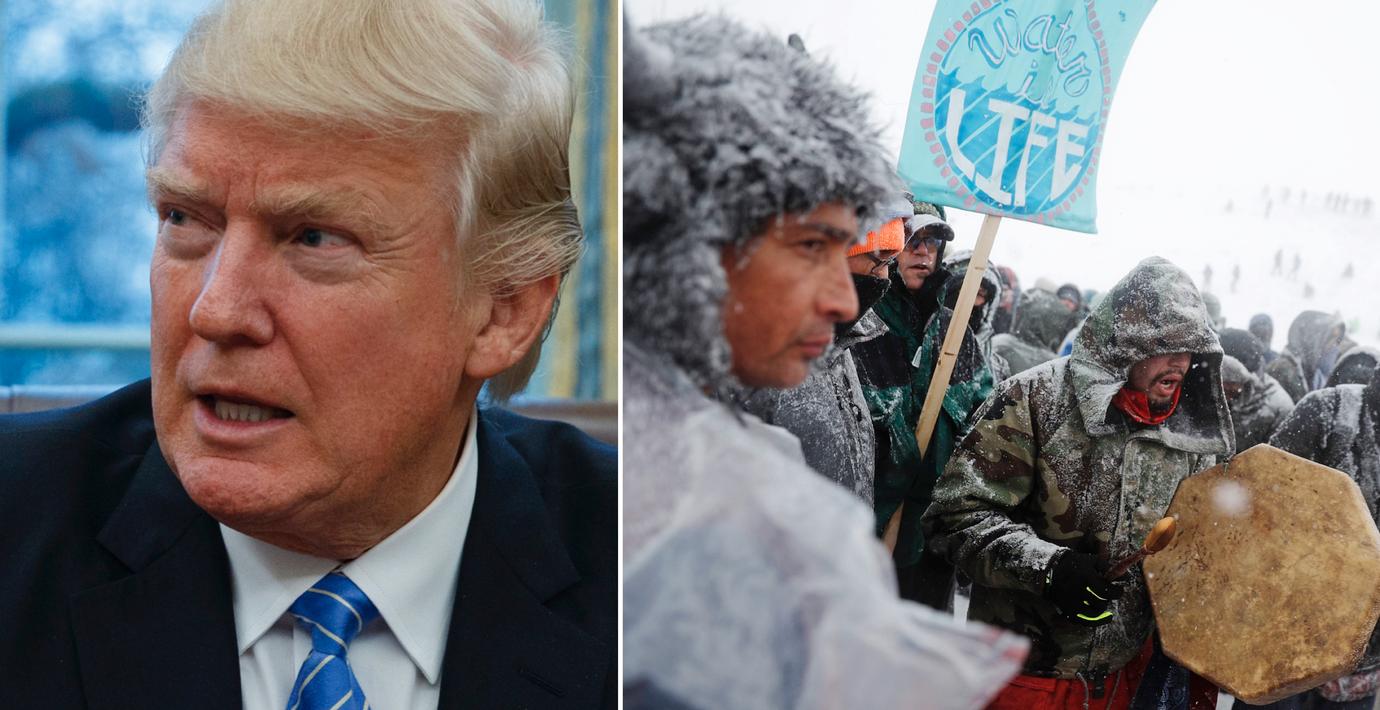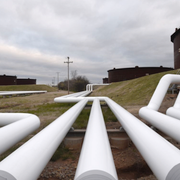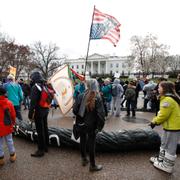
Trump ska återuppliva kritiserade oljeledningar
Donald Trump ska skriva under två exekutiva ordar med syfte att återuppta arbetet med två kritiserade oljeledningar, Dakota Access Pipeline och Keystone XL. Det uppger flera amerikanska medier.
Projektet Dakota Access Pipeline stoppades av Barack Obama efter massiva protester från bland annat ursprungsbefolkningen.
bakgrund
Dakota Access Pipeline
Wikipedia (sv)
Dakota Access Pipeline (DAPL) eller Bakken Pipeline, är en planerad underjordisk oljeledning, som ska gå från ett oljefält i nordöstra North Dakota, via South Dakota och Iowa till södra Illinois, en sträcka på 1825 km. Den planerade oljeledningen ska komplettera North Dakota Pipeline och transportera råolja till en oljedepå i Patoka, nära Chicago.
Projektet planeras av Dakota Access, LLC, ett dotterföretag till Dallas, Texas corporation Energy Transfer Partners, L.P. De långt gångna planerna på projektet har mött stark kritik, bland annat av bondeorganisationer och ursprungsinvånare.
Rörledningen är kontroversiell med tanke på miljörisker och utsläppsmål. Nyttoeffekten för samhället är också ifrågasatt. I North Dakota har protester pågått sedan april 2016 och dessa har uppmärksammats internationellt.
bakgrund
Keystone Pipeline
Wikipedia (en)
The Keystone Pipeline System is an oil pipeline system in Canada and the United States, commissioned in 2010. It runs from the Western Canadian Sedimentary Basin in Alberta to refineries in Illinois and Texas, and also to oil tank farms and an oil pipeline distribution center in Cushing, Oklahoma. The pipeline came to a greater prominence of attention when a planned fourth phase, Keystone XL, attracting growing environmental protest, became a symbol of the battle over climate change and fossil fuels, and in 2015 was rejected by United States President Barack Obama.
Three phases of the project are in operation. They are:
The Keystone Pipeline (Phase I), delivering oil from Hardisty, Alberta, over 3,456 kilometres (2,147 mi) to the junction at Steele City, Nebraska, and on to Wood River Refinery in Roxana, Illinois, and Patoka Oil Terminal Hub (tank farm) north of Patoka, Illinois, completed in June 2010.
The Keystone-Cushing extension (Phase II), running 468 kilometres (291 mi) from Steele City to storage and distribution facilities (tank farm) at Cushing, Oklahoma, completed in February 2011.
The Gulf Coast Extension (Phase III), running 784 kilometres (487 mi) from Cushing to refineries at Port Arthur, Texas was completed in January 2014, and a lateral pipeline to refineries at Houston, Texas and a terminal will be completed mid-2016, going online the following year.
The proposed Keystone XL Pipeline (Phase IV) would have essentially duplicated the Phase I pipeline between Hardisty, Alberta, and Steele City, Nebraska, with a shorter route and a larger-diameter pipe. It would run through Baker, Montana, where American-produced light crude oil from the Williston Basin (Bakken formation) of Montana and North Dakota would be added to the Keystone's current throughput of synthetic crude oil (syncrude) and diluted bitumen (dilbit) from the oil sands of Canada. However, after more than six years of review, President Barack Obama announced on November 6, 2015, his administration's rejection of the fourth phase. The President-elect of the United States, Donald Trump, has stated that he would "absolutely approve it, 100 percent."
The first two phases have the capacity to deliver up to 590,000 barrels per day (94,000 m3/d) of oil into the Mid-West refineries. Phase III has capacity to deliver up to 700,000 barrels per day (110,000 m3/d) to the Texas refineries. By comparison, U.S. oil production averaged 9,400,000 barrels per day (1,490,000 m3/d) in first-half 2015, with gross exports of 500,000 barrels per day (79,000 m3/d) through July 2015.
Omni är politiskt obundna och oberoende. Vi strävar efter att ge fler perspektiv på nyheterna. Har du frågor eller synpunkter kring vår rapportering? Kontakta redaktionen



